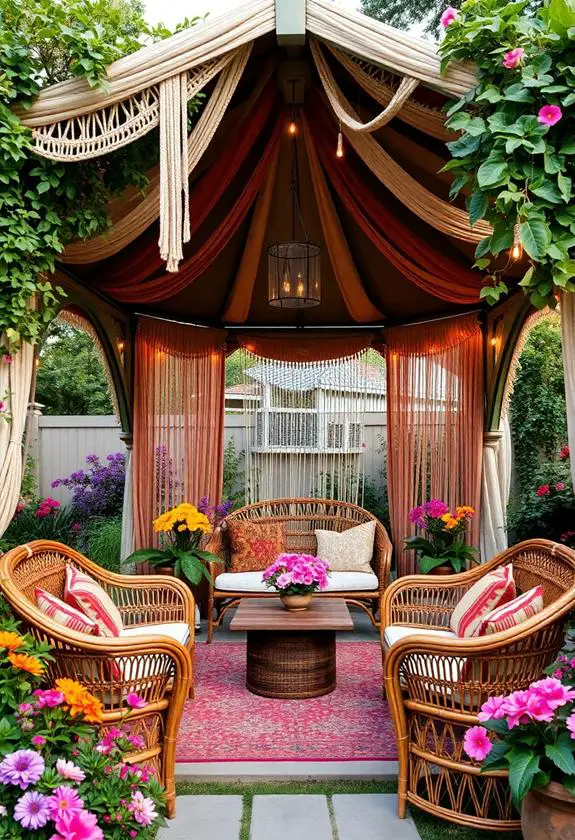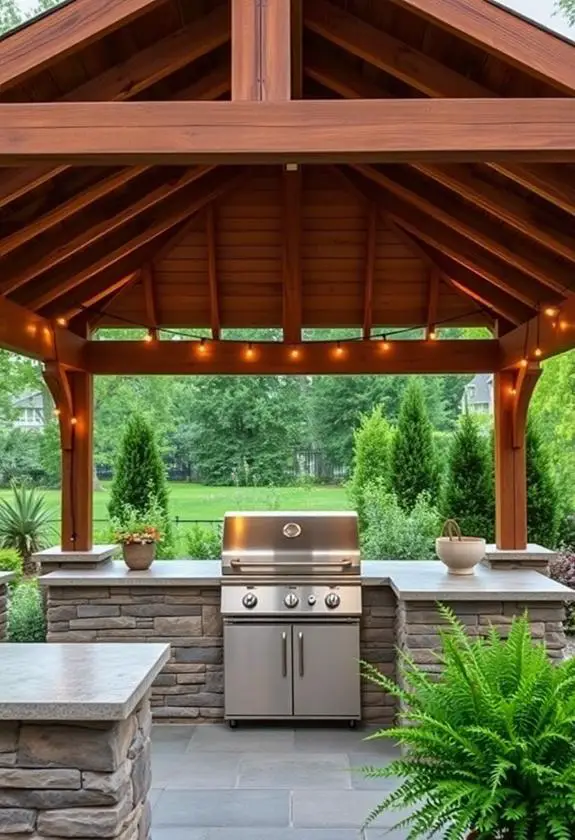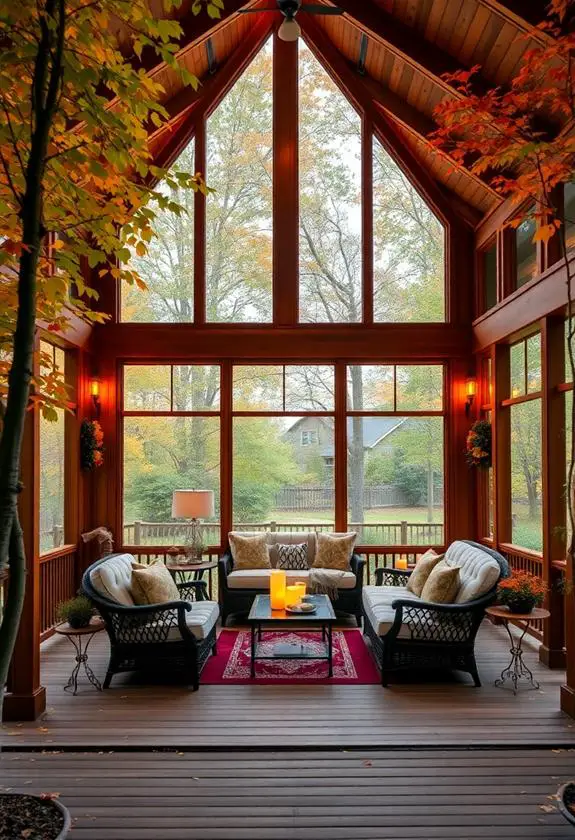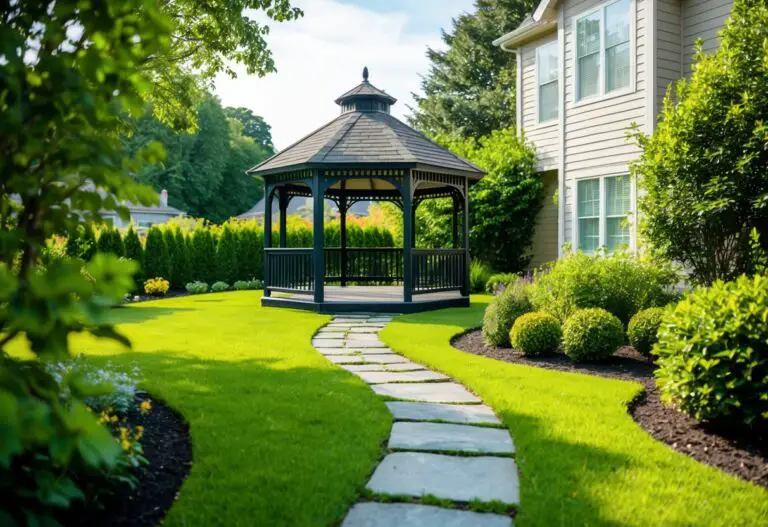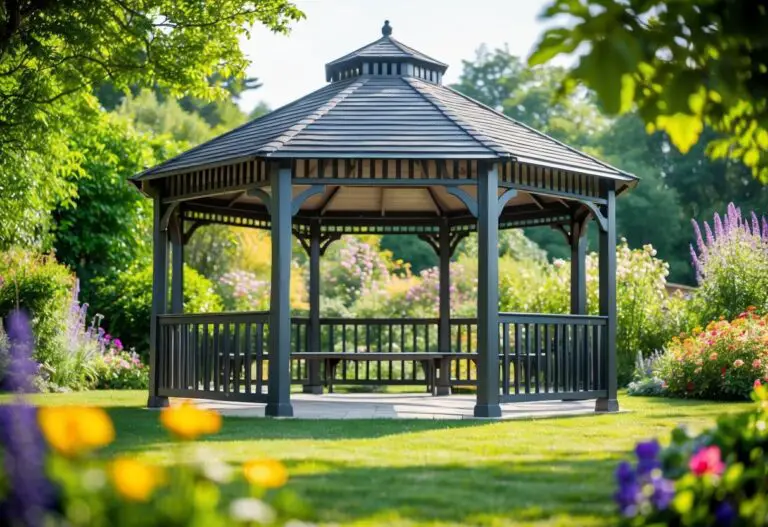Have you ever noticed the small holes in your gazebo’s roof and wondered about their purpose? These openings aren’t just for show – they serve important functions that make your outdoor shelter more enjoyable and long-lasting. Gazebo holes allow for better airflow, prevent water buildup, and add to the structure’s visual appeal.

Imagine sitting in your backyard gazebo on a hot summer day. The holes in the roof let hot air escape, keeping you cool and comfortable. When it rains, these same openings help water drain off instead of pooling on top. This smart design feature protects your gazebo from damage and extends its life.
But there’s more to gazebo holes than just practicality. Many manufacturers now incorporate them into eye-catching patterns, turning a functional element into a decorative one. Next time you relax in your outdoor living space, take a moment to appreciate how these small details enhance your experience.
Key Takeaways
- Holes in gazebos improve airflow and prevent water damage
- They serve both practical and aesthetic purposes
- Regular maintenance of these openings keeps your gazebo in top shape
Purpose Of Holes In Gazebos
You might wonder why your gazebo has holes. These small openings serve important functions that make your outdoor space more enjoyable.
Ventilation is a key reason for gazebo holes. They let air flow freely, keeping you cool on hot days. Without them, your gazebo could feel stuffy and uncomfortable.
Holes also help with moisture control. They allow damp air to escape, reducing humidity inside. This can prevent mold and mildew growth on your gazebo’s surfaces.
Drainage is another vital purpose. Holes in the roof let rainwater run off instead of pooling. This protects your gazebo from water damage and keeps you dry during light showers.
Some holes are purely for looks. They can create pretty light patterns or hold decorations like wind chimes or hanging plants. This adds charm to your outdoor space.
Practical uses include spots for securing curtains or mosquito nets. You can also run electrical cords through them for lighting or fans.
In pop-up gazebos, holes help with setup. They guide you in placing stakes or anchors correctly. This makes assembly quicker and ensures your gazebo stays put in windy weather.
Benefits Of Holes In Gazebos
Gazebo holes offer more perks than you might think. They keep you cool on hot days by letting air flow freely. This makes your gazebo a comfy spot to relax outside.
The holes also fight mold and mildew. By reducing dampness, they help your gazebo stay clean and fresh.
When it’s time to set up your gazebo, those holes come in handy. They act as guides for stakes or anchors. This makes putting it together much easier and more precise.
Wind can be tough on gazebos. But the holes help by letting air pass through. This cuts down on wind pressure and keeps your gazebo steady.
Rainy days aren’t a problem either. The holes let water drain off instead of pooling on top. This stops your gazebo from getting too heavy or damaged.
You’ll enjoy your gazebo more thanks to these smart design features. The holes work hard to keep you comfortable and your structure sound all year round.
Types Of Holes And Their Uses
Gazebos often have different types of holes, each serving a unique purpose. You’ll find these holes in various parts of the structure, from the roof to the walls.
Roof holes are a common feature in many gazebos. These openings allow hot air to escape, keeping you cool on warm days. They also let natural light filter in, creating a bright and inviting space.
Wall holes are another type you might notice. These openings help air move through the gazebo, giving you a nice breeze. Some gazebos use wall holes for decoration too, adding a touch of style to the structure.
Grommet holes are small but important. You’ll see these reinforced openings along the edges of fabric gazebo covers. They help attach the cover securely and prevent tearing.
Here’s a quick look at the main types of holes:
- Roof holes: For ventilation and light
- Wall holes: For airflow and decor
- Grommet holes: For secure attachment
These holes work together to make your gazebo more comfortable and functional. They help manage wind pressure, keep the air fresh, and add to the overall design. Next time you’re in a gazebo, take a moment to notice these clever features!
Maintenance And Care
Keeping your gazebo in top shape is easy with a few simple steps. Start by giving it a good clean every few months. Use a soft brush and mild soap to scrub away dirt and grime. Don’t forget about those holes! They need attention too.
Check the holes regularly for any blockages. Leaves, twigs, and other debris can build up over time. Clear them out to keep water flowing freely. This helps prevent damage to your gazebo’s structure.
Protect your gazebo from the elements with a waterproof spray. Apply it to the fabric, ropes, and wooden parts. This will help keep everything dry and resist mold growth.
Take a close look at the foundation. Make sure it’s level and stable. If you notice any shifting, address it quickly to avoid bigger problems down the road.
Here’s a quick checklist for your gazebo care routine:
- Clean surfaces with soap and water
- Clear holes of debris
- Apply waterproof spray
- Check foundation stability
- Inspect ropes for wear
By following these tips, you’ll keep your gazebo looking great and lasting for years to come. Remember, a little care goes a long way in protecting your outdoor oasis.
Design And Aesthetic Considerations
Gazebo holes aren’t just functional – they can be beautiful too! You’ll find that these openings come in all sorts of fun patterns and shapes. From delicate lattice designs to bold geometric cutouts, there’s a style to match any outdoor decor.
The holes frame scenic views, turning your gazebo into a picture-perfect spot. Imagine gazing out at a lovely garden or sunset through an artfully designed opening. It’s like nature’s artwork on display!
You can customize the hole patterns to put your personal stamp on the gazebo. Some options let you choose the size, shape, and arrangement of the openings. This way, your gazebo becomes a unique expression of your style.
The material you pick for your gazebo affects both how it looks and how long it lasts. Wood gives a classic, natural feel but needs more upkeep. Metal is sturdy and modern-looking. Vinyl is low-maintenance and comes in lots of colors.
Don’t forget about curtains! They’re a great way to dress up your gazebo holes. You can use them to add pops of color or create a cozy, private space. Plus, they’re easy to change with the seasons or your mood.
Frequently Asked Questions
Gazebo holes serve important purposes for ventilation, drainage, and structural integrity. Let’s look at some common questions about these useful openings.
What’s the purpose of having vent holes in a gazebo canopy?
Vent holes in gazebo canopies allow air to flow freely. This keeps the space inside cool and comfortable on hot days. The holes also let smoke from grills or humidity escape upwards.
Is a roof vent necessary for a gazebo structure?
A roof vent is very helpful for gazebos. It prevents hot air from getting trapped inside. The vent also reduces moisture buildup that could damage the gazebo over time.
How do holes in the roof of a gazebo affect its functionality?
Roof holes improve a gazebo’s function in several ways. They help rainwater drain properly to avoid pooling. The holes also create nice light patterns inside the gazebo for a prettier look.
What benefits do roof vents provide to gazebo integrity?
Roof vents help gazebos last longer. They reduce stress on the structure from wind by letting air pass through. Vents also help prevent mold and rot by keeping the gazebo dry.

